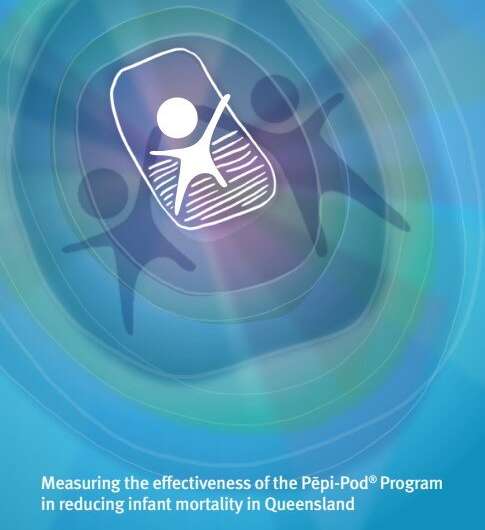

University of the Sunshine Coast research aimed at preventing infant deaths associated with suffocation has been linked to a 22% reduction in Queensland’s infant mortality rate.
An analysis of USC’s Pēpi-Pod research program found that the 22% reduction in the state’s infant mortality rate from 2014 onwards aligned with the program’s expansion into maternal and child health services across various geographic regions.
The report by the Queensland Pediatric Quality Council, the University of the Sunshine Coast and the University of Auckland also found an astounding 75% reduction in the infant mortality rate in areas of the state’s west and far north with the highest level of community participation in the program.
Pēpi-pods are portable infant beds which create a zone of physical protection for a baby within a shared bed or other risk location.
These purpose-designed sleep spaces are supplied to expectant and new mothers along with personalized education about infant breathing and safe sleeping strategies.
Another key element is engaging parents as peer communicators within their own social networks and supporting them through ongoing communication with health care workers.
UniSC Professor of Nursing and report co-author Jeanine Young AM said, “These results are really exciting for services and families across Queensland, particularly in Aboriginal and Torres Strait Islander communities which partnered with us to introduce the program as a pilot in 2011.”
Professor Young said although a retrospective analysis could not prove the program was responsible for lower mortality rates, the timelines and locations of infant mortality reductions indicated very strong associations.
“In addition, the very positive feedback from participant families and health care workers has prompted us to seek immediate funding for statewide implementation to save more Queensland lives,” she said.
The report calls for government funding to expand the successful program over eight years, alongside real-time evaluation of its effects on the health and safety of infants under six months old.
Queensland has a 30% higher infant mortality rate than the rest of Australia and Sudden Unexpected Death in Infancy (SUDI) is the leading category of death after the first four weeks of life.
SUDI relates to infants under 12 months who die suddenly and unexpectedly, typically during sleep and where the cause is not immediately apparent.
Risks which increase an infant’s vulnerability include smoke exposure, low birth weight, mothers under the age of 20, remote locations, social vulnerability and substance and alcohol use.
Professor Young said the report confirmed that sleeping in unsafe circumstances was a factor in almost every death in this category between 2013 and 2016.
“The Pēpi-Pod Program, designed by social innovation company Change for our Children, aims to separate the hazardous combination of antenatal smoking and direct bedsharing which reportedly increases risk of infant death up to 33-fold,” she said.
She said that since the USC research finished in 2018, the Pēpi-Pod Program had continued only on an ad hoc basis in communities with support from non-government services or philanthropists.
“While there is training underway at hospitals in Wide Bay, Redcliffe and Caboolture via a Queensland Technology Futures Fund grant, this study, Measuring the effectiveness of the Pēpi-Pod Program in reducing infant mortality in Queensland, demonstrates the need for systematic, statewide delivery,” Professor Young said.
“The potential benefits are enormous, given that Queensland recorded 15 fewer deaths a year during this study, compared to an average of more than 50 each year.
“The cost of this intervention—about $1.4 million a year—would be extremely modest compared with what our Australian society has said it is prepared to pay for each life saved.”
In the report, Queensland Pediatric Quality Council Co-Chair Dr. Julie McEniery confirmed a much higher SUDI rate in Aboriginal and Torres Strait Islander families and concluded: “Improving the safety of the sleeping environment is a key strategy to prevent deaths.”
Source: Read Full Article